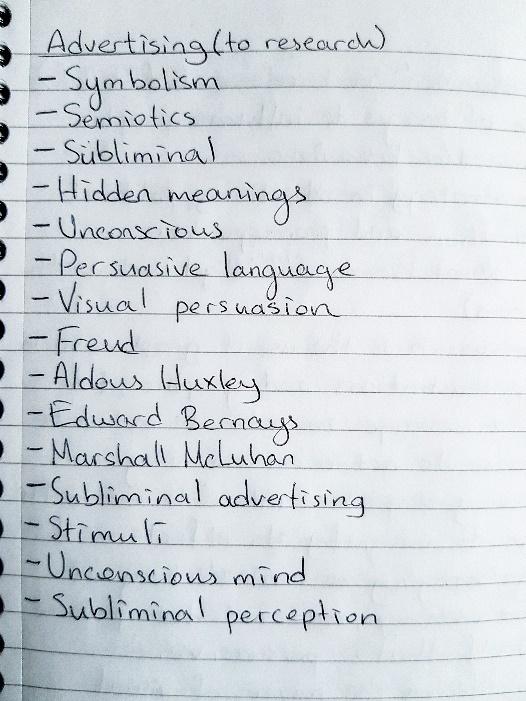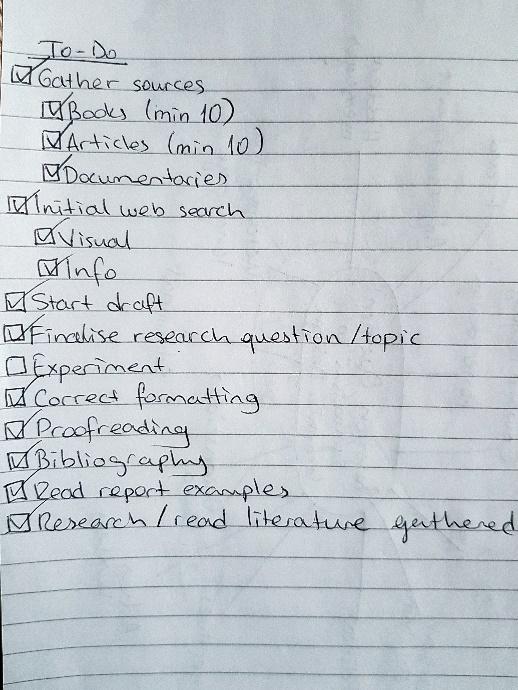
3 minute read
Research Methodology………………………………………………………..…..……………p
by diliri
Research Methodology
The first step I always take starting a research project or a study is to plan everything that I believe needs to be considered and the places I can look at to find the information needed. Consequentially, I created a list (Fig1) of the keywords and terms I wanted to use to start my initial exploration of the research topic. In this case, I created a ‘To-Do’ list(Fig2)with the tasks I needed to do in order to have the most comprehensive understanding of the subject while managing my time.This plan helped me later tokeep my focus on the question as while reminding me to look at subtopics and understand the main concept better. After the planning or mind mapping session was complete, I started an initial onlinesearch. Even though I had somewhat knowledge on subliminal Figure 1 Keywords list I created to help me perception and its use in advertising, I searched as with the direction of my research though it was a completely new topic for me. I started looking at articles and blog posts about subliminal perceptions, subliminal persuasive approaches and definitions of related termson various websites. This initial exploration stage put me in a great point to start studying the field in more depth.I started looking at examples of media that subliminal messages have been applied to (or tried to –I will explain the controversy of the subjects related to subliminal persuasion later in the chapters). Collecting images as I go, to include in this report as examples,I startedexamining. I understood that there were different types of subliminal or hidden messagesused in various media. As shown on the diagram below I developed that representsmy research methodology (Fig3), I go back and repeat Figure 2 A To-Do list I made in the early stages some steps for an extensivedata collection. To of my planning (not in the order) search and find good sources for related literature, I
Advertisement

used numerous platforms including university’s library search, digital journal archives, video streaming platforms as well as my own book collection. I first gathered all the sourcesinto my digital and physical workspace, then started reading them from most related to least.I took exhaustivenotes into my dedicated notebook along the way, marked the points that were crucial to include in the report.At the end of thiscollection, explorationand learning process, the main ideas and points of arguments start to be shaped in my mind. I knew at this point what my research question was going to be and how I would address it. I wanted to explore aroundthe question “How does subliminal advertising communicate with the viewer aiming to change behaviour through subliminal stimuli?”, becauseI have a personal interest in the movement ‘Symbolism’ and Sigmund Freud’s psychoanalytic theories.Therefore, naturally I find the concept of subliminal perception and persuasion very fascinating.At this stage of the researching journey, I had an in-depth understand of the theory and the techniques of subliminal perceptions and had a more analytical perspective while studying new materials. It is usually at this point where I do some free searching,which I also like to call ‘chaotic learning’. This is where I start with onesource, then jump to another recommended one. For instance, when I was reading the Trappey’s article “A Meta-Analysisof Consumer Choice and Subliminal Advertising”(1996), I found an interesting point made that was cited of Moore’s “Subliminal Advertising: What You See Is What You Get” (1982). It turned out this article was a crucial literature in the development of the subliminal concepts.After this free learning process, I went back to the beginning, organising all the findings, analysing them once more with an inquisitiveperspective.This was when I started my first draft. I initially planned to conductan experiment with a group of volunteerson the subject. However, itwould be the most beneficial and constructive approach to do the experiment in a controlled environmentunder the right circumstances in order to get precise results(Gafford, 1995).Due to the current situations related to Covid-19 and the lockdown regulations, I was unable to proceed with the experiment. Therefore, I relied onthe previous experiments done by the researchers to analyse and compare the various results and evidences.I do plan on further study this subject in the future and perhaps expand this report.

Figure 3 'Research Methodology' diagram I designed representing my researching journey



